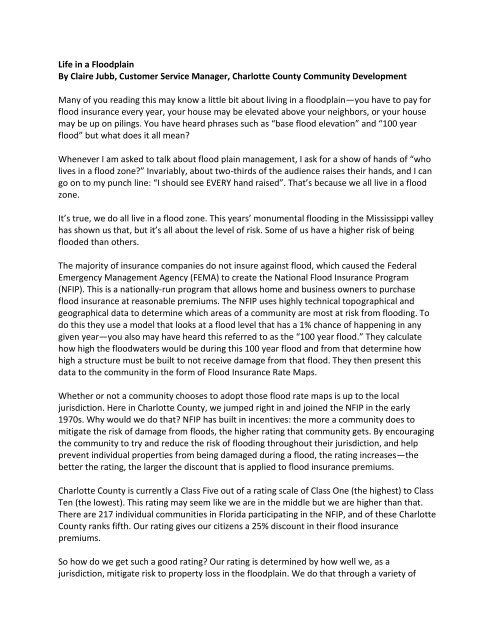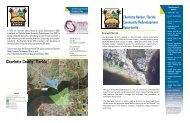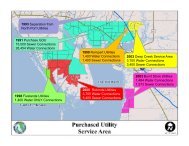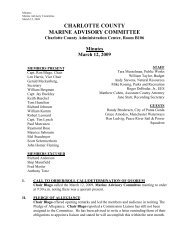Life in a Floodplain By Claire Jubb, Customer Service Manager ...
Life in a Floodplain By Claire Jubb, Customer Service Manager ...
Life in a Floodplain By Claire Jubb, Customer Service Manager ...
Create successful ePaper yourself
Turn your PDF publications into a flip-book with our unique Google optimized e-Paper software.
<strong>Life</strong> <strong>in</strong> a Floodpla<strong>in</strong><strong>By</strong> <strong>Claire</strong> <strong>Jubb</strong>, <strong>Customer</strong> <strong>Service</strong> <strong>Manager</strong>, Charlotte County Community DevelopmentMany of you read<strong>in</strong>g this may know a little bit about liv<strong>in</strong>g <strong>in</strong> a floodpla<strong>in</strong>—you have to pay forflood <strong>in</strong>surance every year, your house may be elevated above your neighbors, or your housemay be up on pil<strong>in</strong>gs. You have heard phrases such as “base flood elevation” and “100 yearflood” but what does it all mean?Whenever I am asked to talk about flood pla<strong>in</strong> management, I ask for a show of hands of “wholives <strong>in</strong> a flood zone?” Invariably, about two-thirds of the audience raises their hands, and I cango on to my punch l<strong>in</strong>e: “I should see EVERY hand raised”. That’s because we all live <strong>in</strong> a floodzone.It’s true, we do all live <strong>in</strong> a flood zone. This years’ monumental flood<strong>in</strong>g <strong>in</strong> the Mississippi valleyhas shown us that, but it’s all about the level of risk. Some of us have a higher risk of be<strong>in</strong>gflooded than others.The majority of <strong>in</strong>surance companies do not <strong>in</strong>sure aga<strong>in</strong>st flood, which caused the FederalEmergency Management Agency (FEMA) to create the National Flood Insurance Program(NFIP). This is a nationally-run program that allows home and bus<strong>in</strong>ess owners to purchaseflood <strong>in</strong>surance at reasonable premiums. The NFIP uses highly technical topographical andgeographical data to determ<strong>in</strong>e which areas of a community are most at risk from flood<strong>in</strong>g. Todo this they use a model that looks at a flood level that has a 1% chance of happen<strong>in</strong>g <strong>in</strong> anygiven year—you also may have heard this referred to as the “100 year flood.” They calculatehow high the floodwaters would be dur<strong>in</strong>g this 100 year flood and from that determ<strong>in</strong>e howhigh a structure must be built to not receive damage from that flood. They then present thisdata to the community <strong>in</strong> the form of Flood Insurance Rate Maps.Whether or not a community chooses to adopt those flood rate maps is up to the localjurisdiction. Here <strong>in</strong> Charlotte County, we jumped right <strong>in</strong> and jo<strong>in</strong>ed the NFIP <strong>in</strong> the early1970s. Why would we do that? NFIP has built <strong>in</strong> <strong>in</strong>centives: the more a community does tomitigate the risk of damage from floods, the higher rat<strong>in</strong>g that community gets. <strong>By</strong> encourag<strong>in</strong>gthe community to try and reduce the risk of flood<strong>in</strong>g throughout their jurisdiction, and helpprevent <strong>in</strong>dividual properties from be<strong>in</strong>g damaged dur<strong>in</strong>g a flood, the rat<strong>in</strong>g <strong>in</strong>creases—thebetter the rat<strong>in</strong>g, the larger the discount that is applied to flood <strong>in</strong>surance premiums.Charlotte County is currently a Class Five out of a rat<strong>in</strong>g scale of Class One (the highest) to ClassTen (the lowest). This rat<strong>in</strong>g may seem like we are <strong>in</strong> the middle but we are higher than that.There are 217 <strong>in</strong>dividual communities <strong>in</strong> Florida participat<strong>in</strong>g <strong>in</strong> the NFIP, and of these CharlotteCounty ranks fifth. Our rat<strong>in</strong>g gives our citizens a 25% discount <strong>in</strong> their flood <strong>in</strong>surancepremiums.So how do we get such a good rat<strong>in</strong>g? Our rat<strong>in</strong>g is determ<strong>in</strong>ed by how well we, as ajurisdiction, mitigate risk to property loss <strong>in</strong> the floodpla<strong>in</strong>. We do that through a variety of
programs. The most obvious is through build<strong>in</strong>g regulations. For example, any new residentialstructure is required to be elevated above the base flood elevation (BFE) and any newcommercial structure is required to be elevated or otherwise flood proofed to the BFE.Another part of our program centers on help<strong>in</strong>g our most flood prone citizens makeimprovements to m<strong>in</strong>imize their flood<strong>in</strong>g risk. This is done through various grant programsavailable through the NFIP and is managed by our Emergency Management Office.Some areas of our program are less obvious. For example, did you know that we require a planto be submitted by every commercial development or subdivision on how they are go<strong>in</strong>g tohandle their storm water runoff? We also monitor how much land is be<strong>in</strong>g preserved as openspace <strong>in</strong> our floodpla<strong>in</strong>s. The more open space we have, either through county-owned parks,golf courses or privately or state-owned land, the more po<strong>in</strong>ts we get towards our rat<strong>in</strong>g.Any outreach projects we host discuss<strong>in</strong>g floodpla<strong>in</strong> management also go a long way toimprov<strong>in</strong>g our rat<strong>in</strong>g. With that <strong>in</strong> m<strong>in</strong>d, if you want to learn more about liv<strong>in</strong>g <strong>in</strong> a flood zone,flood <strong>in</strong>surance or mitigat<strong>in</strong>g aga<strong>in</strong>st loss either with or without grant fund<strong>in</strong>g, please attendour workshop “How to Reduce Repetitive Flood Damage” that will be held at 2 p.m. onWednesday, Sept. 21 <strong>in</strong> Room 119 of the Charlotte County Adm<strong>in</strong>istration Build<strong>in</strong>g, 18500Murdock Circle, Port Charlotte. If you are unable to attend, please do not hesitate to contactme (941.743.1245) for more <strong>in</strong>formation or to discuss any specific issues or questions you mayhave.





